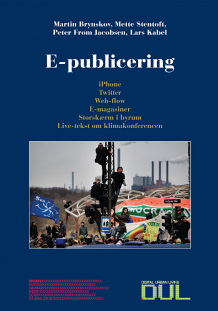|
 New products for digital media platforms – which and how? iPhone, Twitter, Web-flow, E-magazines, Urban Screens, Live text. [Klik her for dansk version] New products for digital media platforms – which and how? iPhone, Twitter, Web-flow, E-magazines, Urban Screens, Live text. [Klik her for dansk version]
While the printed newspaper still is the primary revenue source, the big media organizations must develop and publish new products for digital platforms. These platforms will in the early 2010s supplement print, and then gradually to a large extent take over the printed papers' market position and place in society. Most journalists and media professionals agree on this view, the big questions are just: Which products? How should they be produced? What's the business model?
The research project "New digital stories on web and mobile" has studied such issues for the period August 2009 to March 2010. As part of the national research center Digital Urban Living (DUL), a team of researchers, developers and journalists from UPDATE (Danish School of Media and Journalism) and DUL (Aarhus University) conducted a prolonged development, test and analysis project.
The first results come out in the form of an interim report, "E-publicering" (in Danish), which in seven chapters condenses the findings. The report is available as a free download (PDF) [5 MB].
The project has been implemented in a unique collaboration between DUL researchers and key personnel from Jyllands-Posten's web editorial team, jp.dk, employees from the online publishing company Visiolink, the telecommunications company 3, Climate Secretariat, Municipality of Aarhus, and Culture and Citizens’s Services, Municipality of Aarhus.
Media companies agree that web editors are good at meeting users' needs for breaking news, news updates and gossip. The report provides a series of suggestions to what the 2010s digital journalists and new media organizations also need to master:
- Media organizations must be better than today at meeting readers and users wherever they are. In transit in the public space. In principle, always online via mobile phones like the iPhone. In light of the development and testing of a new iPhone app, KlimaTrends (Climate Trends), the project has gained experience with how digital journalism can handle the smartphone challenge. This is presented in the report.
- TV and radio has for decades had duopoly on live coverage. Not so anymore. Through examples like Twitter, the established newspapers are now able to offer live coverage in real time from significant events. Users can also interact with the news flow. This form of real time reporting appears to have considerable potential for the digital journalism - via tweets from the COP15 climate summit in Copenhagen in December 2009, the project tested and extracted lessons from live text coverage.
- E-magazines are complex multimedia products. The software facilitates the production and publication of larger journalistic narratives and projects. Stories which usually run into difficulties in the rapid web media. E-magazines seem interesting for media organizations. Through practical production of two e-magazines, the project has studied the e-magazine’s editorial potentials and tested ways to produce these, technically and journalistically.
- Media user involvement in the 2000s was based significantly on the amateur journalist and photographer who would send in articles and pictures. This first generation of user involvement is now being superseded by new and more dynamic relations between the editorial staffs and the users. Through social media and various types of micro exchanges, the contours of a second generation of user involvement now emerges. The project has identified and tested this second generation.
- The commentator, the blogger, the journalist with a profile, and the renowned editor-in-chief has significantly shown meaningful presences in social media. Dealing with social media has proved more difficult for the media organization and the more anonymous professional journalist. There is a missing piece of research and development work to be done on the professional voice in social media - how is it different from the personal and more private voice? The project has studied this, and the report has some early suggestions on this.
For further information and comments, please contact:
- Lars Kabel, MA and journalist, associate professor at UPDATE, the Danish School of Media and Journalism, email:
This e-mail address is being protected from spambots. You need JavaScript enabled to view it
, mobile: (+45) 25323787.
- Martin Brynskov, PhD, assistant professor at Dept. of Information and Media Studies, Aarhus University, email:
This e-mail address is being protected from spambots. You need JavaScript enabled to view it
, mobile (+45) 30680424.
Tags: civic communication | iPhone | journalism | news | publication | Twitter |




